Useful Vines for the Garden [August 8, 2015]
Two of the great vines available at the nursery are Vitis californica (California wild grape) and Clematis lasiantha (chaparral clematis). They are both useful habitat plants and can be grown as a ground cover or trained over a trellis or fence. They are tolerant of a wide variety of soils -- from clay to sandy soils.
Clematis lasianta (Chaparral clematis)
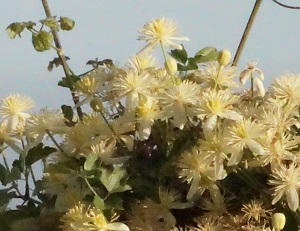 Clematis lasianta, which is also known as chaparral or pipestem clematis, is a lovely vine that is covered with gorgeous white flowers in the spring. The flowers are followed by fluffy white seed heads that make the plants look like they're covered in cottonballs. It can grow fifteen to twenty feet tall. This plant loves full sun although it prefers some shade for its roots. It does not need supplemental water after it is established. It is deciduous and may die back in cold winters, but will quickly grow back in the spring. You can see these vines in flower on many local trails in the spring.
Clematis lasianta, which is also known as chaparral or pipestem clematis, is a lovely vine that is covered with gorgeous white flowers in the spring. The flowers are followed by fluffy white seed heads that make the plants look like they're covered in cottonballs. It can grow fifteen to twenty feet tall. This plant loves full sun although it prefers some shade for its roots. It does not need supplemental water after it is established. It is deciduous and may die back in cold winters, but will quickly grow back in the spring. You can see these vines in flower on many local trails in the spring.
More at Las Pilitas and Calflora.
Vitis californica (California wild grape)
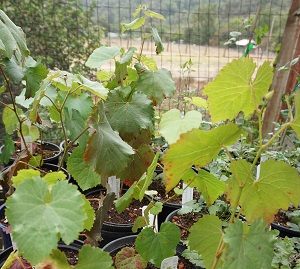
Vitis californica has beautiful, large green leaves that provide an excellent cover in the summer. In the wild, it is typically found along streams and other moist areas, but is adaptable to dry conditions after it is established. It is a deciduous vine that can grow over thirty feet tall. Since it sheds its leaves in the winter, it's great over an arbor or trellis for summer shade and winter sun. It produces bunches of small purple grapes in the fall. The grapes are edible, but tend to be tart.
Maintenance is easy. Agi Kehoe, an active member of the Gardening With Natives subgroup shares these simple pruning instructions:
Winter pruning: thin out the vine by removing all but the major canes that form the structure. Once finished, there should be one mature cane per wire line on a fence, and maybe 3 canes on a 2' wide arbor. Cut the canes back to 2-3 buds, each cut should be 1/4" above the leaf node. This is also the time to secure the large canes to the trellis with ties.
Active growing season pruning: maintain the fast growth. If trained on a fence, prune to keep it close to the fence; if trained on an arbor, leave some fresh green canes hanging down from the arbor to create a softer look.
More at Las Pilitas Nursery and Calflora.
Gardening with Natives Resources and Handouts
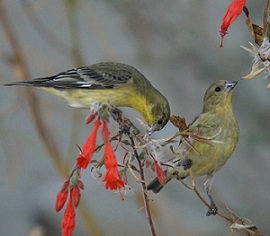
Here are links to some of our popular handouts. Free to download.
Native Trees of San Mateo and Santa Clara Counties
| Aceraceae (Maple Family) |
|---|
| Acer macrophyllum |
big-leaf maple |
| Acer negundo var. californicum |
box elder |
| Betulaceae (Birch Family) |
|---|
| Alnus rhombifolia |
white alder |
| Caprifoliaceae (Honeysuckle Family) |
|---|
| Sambucus mexicana |
blue elderberry |
| Ericaceae (Heath Family) |
|---|
| Arbutus menziesii |
Pacific madrone |
| Fagaceae (Oak Family) |
|---|
| Lithocarpus densiflorus |
tanbark oak |
| Quercus agrifolia |
coast live oak |
| Quercus chrysolepis |
canyon live oak |
| Quercus douglasii |
blue oak |
| Quercus garryana |
Oregon white oak |
| Quercus kelloggii |
California black oak |
| Quercus lobata |
valley oak |
| Quercus wislizeni |
interior live oak |
| Hippocastanaceae (Buckeye Family) |
|---|
| Aesculus californica |
California buckeye |
| Lauraceae (Laurel Family) |
|---|
| Umbellularia californica |
California laurel |
| Oleaceae (Olive Family) |
|---|
| Fraxinus dipetala |
flowering ash |
| Fraxinus latifolia |
Oregon ash |
| Pinaceae (Pine Family) |
|---|
| Pinus attenuata |
knobcone pine |
| Pinus ponderosa |
Pacific ponderosa pine |
| Pinus sabiniana |
gray pine |
| Pseudotsuga menziesii |
Douglas fir |
| Platanaceae (Sycamore Family) |
|---|
| Platanus racemosa |
Western sycamore |
| Salicaceae (Willow Family) |
|---|
| Populus fremontii ssp. fremontii |
Fremont cottonwood |
| Populus balsamifera ssp. trichocarpa |
black cottonwood |
| Salix laevigata |
red willow |
| Salix lasiolepis |
arroyo willow |
| Salix lucida ssp. lasiandra |
shining willow |
| Taxaceae (Yew Family) |
|---|
| Torreya californica |
California nutmeg |
| Taxodiaceae (Bald Cypress Family) |
|---|
| Sequoia sempervirens |
redwood |
California Native Trees for the Landscape
There are many California native trees that work well in landscapes. Our locally native trees deserve to be cultivated more often in the San Francisco Bay area, and this list focuses primarily on them. They are well adapted to our climate and soils and provide special value for wildlife. For more information about these trees, please visit calscape.org.
Trees 20 Feet and Under
Blue Elderberry (Sambucus mexicana) is a fast growing deciduous tree with summer fruit that attract a wider range of birds than any other tree. Songbirds favor it highly for food and nesting. It is easy to grow and can adapt to both dry and moist conditions. It is very amenable to pruning.
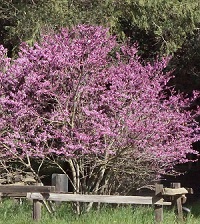 Western Redbud (Cercis occidentalis) is a deciduous tree that is covered in stunning pink flowers just before leaf emergence in the spring. It is a small tree - growing up to 20' and is fairly tolerant of a wide variety of soils, including clay. While not locally native, it grows well in the Bay Area. There are some beautiful specimens growing near the CNPS SCV Nursery at Hidden Villa in Los Altos Hills.
Western Redbud (Cercis occidentalis) is a deciduous tree that is covered in stunning pink flowers just before leaf emergence in the spring. It is a small tree - growing up to 20' and is fairly tolerant of a wide variety of soils, including clay. While not locally native, it grows well in the Bay Area. There are some beautiful specimens growing near the CNPS SCV Nursery at Hidden Villa in Los Altos Hills.
Arctostaphylos 'Dr. Hurd' (Dr. Hurd Manzanita) is a lovely choice if you need a small tree. While most manzanitas are closer to shrub in size, this is one of the tallest and can grow up to 15' tall (and wide). It originated in a garden in Portola Valley and does well in a wide variety of garden situations.
Ceanothus 'Ray Hartman' can grow up to 20' and is covered in beautiful blue flowers in early spring. It grows fairly quickly and is a good choice if you need a small, well-behaved tree. It can also be trained as a large shrub.
Western Mountain Mahogany (Cercocarpus betuloides) is found through much of the state. It can reach 15-20’. It can be trained into a single-trunked tree, but is often shrub-like in form with several main trunks when left to grow freely. In late spring, this small tree is covered with 1 - 2 inch long spiral seed heads which appear silver in the afternoon light.
The California Scrub Oak (Quercus berberidifolia) is a small oak that can reach up to 20'. However it grows very slowly, and is usually found as a small, compact shrub. A good choice for those who do not have the space for one of the larger oaks. Can be difficult to find in nurseries. Learn why it's important to plant oaks.
Trees Over 20 Feet
Valley oak (Quercus lobata) and coast live oak (Quercus agrifolia) grow fairly quickly and are easy to cultivate. Another wonderful local oak is canyon live oak (Quercus chrysolepis). This is the most widely distributed of our native oaks in California.While ancient trees which grew to maturity under summer dry conditions may resent summer irrigation, young oaks adapt to garden watering. Indeed, under garden conditions seedling oaks may reach 25 feet in ten years--they actually grow faster than many commonly planted trees! Learn why it's important to plant oaks.
Hollyleaf Cherry (Prunus ilicifolia) is an attractive evergreen tree with leaves that look similar to holly. It has pretty white flower clusters in the spring followed by small cherries with large pits that are popular with birds. It can grow up to 50' tall.
California Buckeye (Aesculus californica) is a beautiful tree with spectacular flower clusters in late winter and early spring. While it can grow up to 40' tall, it grows quite slowly, making it practical for even smaller gardens. Read this wonderful article about buckeyes by Roger Raiche to learn more about this lovely tree.
The California Bay Laurel (Umbellularia californica) becomes a stately evergreen tree that can reach 60'. Its fragrant leaves can be used in cooking (although in smaller quantities than its Mediterranean relative, the bay tree). It releases chemicals that supress other plants from growing, so it should not be siturated where understory plantings are desired.
The Pacific madrone (Arbutus menziesii) is one of the world's most beautiful broadleaf evergreen trees. It can grow up to 100', but is more commonly 25-40' in dry conditions. It be challenging to cultivate in a home garden, but it is a spectactular addition to the garden for those who are fortunate enough to grow it successfully.
Big-leaf maple (Acer macrophyllum) is very attractive, but it needs some moisture and does well when planted close to a water source. It can grow over 65' tall so be sure to plant it where there is enough space because it is fast growing in the right conditions.
The coast redwood is met with too often in cultivation locally. It does best when planted in cool areas with significant fog drip. The temptation to plant this tree in dry inland areas has resulted in many dead or dying trees. Unless you live in an area where these trees grow naturally, resist the urge to plant one.
Butterfly Gardening
calscape.org: CNPS database of native plants and associated butterflies and moths (both host and nectar plants). Searchable.
California Plants as Resources for Lepidoptera: a document that lists many moth and butterfly species and their host & nectar plants
BUTTERFLY GARDENING: SELECTED REFERENCES
Arbuckle, Nancy and Cedric Crocker (eds.). 1991. How to Attract Hummingbirds and Butterflies. Ortho Books.
Caldwell, Jeff. Notes on Larval Food Plants of Some Bay Area Butterflies. 3pp.-xeroxed
Garth, John S. and J.W. Tilden. 1986. California Butterflies. Berkeley: University of California Press.
Stewart, Bob. 1997. Common Butterflies of California. Point Reyes Station, CA: West Coast Lady Press.
Stokes, Donald, Lillian Stokes and Ernest Williams. 1991. The Butterfly Book: An Easy Guide to Butterfly Gardening, Identification, and Behavior. Little, Brown and Company.
Tekulsky, Mathew. 1985. The Butterfly Garden. Boston: The Harvard Common Press.
Xerces Society/Smithsonian Institution. 1990. Butterfly Gardening. Sierra Club Books.
Locally Native Trees for Landscaping
Our locally native trees are beautiful and easy to grow--they are well adapted to our climate and soils. Native trees offer special values for wildlife as well.
The valley oak and coast live oak, two beautiful species, grow fairly quickly and are easy to cultivate. While ancient trees which grew to maturity under summer dry conditions may resent irrigation, young oaks adapt to garden watering. Indeed, under garden conditions oaks may reach 25 feet in ten years--they actually grow faster than many commonly planted trees! Our native oaks deserve to be planted far more often than they are. There are smaller oaks if you do not have space for a large tree -- the scrub oak is a beautiful little tree that stays under 20' while providing the same habitat benefits as its larger relatives.
Our California laurel becomes a stately tree. It is slow growing, but well-situated specimens are a fine gift to future generations.
The madrone is one of the world's most beautiful broadleaf evergreen trees. It can be challenging to establish, but if you like a gardening challenge, try this treasure!
The California buckeye has interesting fruits, spectacular flowers and exquisite spring foliage. It is the first to drop its leaves after the end of the rainy season, revealing its lovely structure as the deciduous leaves turn brown. Its flowers have pollen that is somewhat toxic to the non-native honeybee, but no flowers have more value to butterflies and native bees. In bloom this tree is often festooned with butterflies.! The tiger swallowtail, mourning cloak, California sister, California tortoiseshell, spring azure and many others visit this tree. It is easy to grow.
Blue elderberry has summer fruit that attract a wider range of birds than any other tree. Songbirds favor it highly for food and nesting. It is easy to grow and very fast. A stump-sprouter, it is amenable to pruning.
If you have space, big-leaf maple is a very attractive species, and also fast growing--it deserves a place in more landscapes.
Native Trees of San Mateo and Santa Clara Counties
| Aceraceae (Maple Family) |
|---|
| Acer macrophyllum |
big-leaf maple |
| Acer negundo var. californicum |
box elder |
| Betulaceae (Birch Family) |
|---|
| Alnus rhombifolia |
white alder |
| Caprifoliaceae (Honeysuckle Family) |
|---|
| Sambucus mexicana |
blue elderberry |
| Ericaceae (Heath Family) |
|---|
| Arbutus menziesii |
Pacific madrone |
| Fagaceae (Oak Family) |
|---|
| Lithocarpus densiflorus |
tanbark oak |
| Quercus agrifolia |
coast live oak |
| Quercus chrysolepis |
canyon live oak |
| Quercus douglasii |
blue oak |
| Quercus garryana |
Oregon white oak |
| Quercus kelloggii |
California black oak |
| Quercus lobata |
valley oak |
| Quercus wislizeni |
interior live oak |
| Hippocastanaceae (Buckeye Family) |
|---|
| Aesculus californica |
California buckeye |
| Lauraceae (Laurel Family) |
|---|
| Umbellularia californica |
California laurel |
| Oleaceae (Olive Family) |
|---|
| Fraxinus dipetala |
flowering ash |
| Fraxinus latifolia |
Oregon ash |
| Pinaceae (Pine Family) |
|---|
| Pinus attenuata |
knobcone pine |
| Pinus ponderosa |
Pacific ponderosa pine |
| Pinus sabiniana |
gray pine |
| Pseudotsuga menziesii |
Douglas fir |
| Platanaceae (Sycamore Family) |
|---|
| Platanus racemosa |
Western sycamore |
| Salicaceae (Willow Family) |
|---|
| Populus fremontii ssp. fremontii |
Fremont cottonwood |
| Populus balsamifera ssp. trichocarpa |
black cottonwood |
| Salix laevigata |
red willow |
| Salix lasiolepis |
arroyo willow |
| Salix lucida ssp. lasiandra |
shining willow |
| Taxaceae (Yew Family) |
|---|
| Torreya californica |
California nutmeg |
| Taxodiaceae (Bald Cypress Family) |
|---|
| Sequoia sempervirens |
redwood |
CNPS SCV Nursery
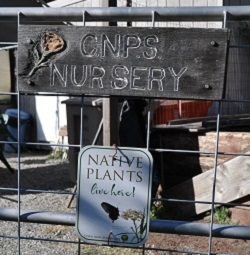
CNPS SCV Nursery
-- founded by Jean and David Struthers
Where ecology and horticulture connect.
The Santa Clara Valley Chapter of CNPS maintains the CNPS SCV Nursery on the grounds of Hidden Villa in Los Altos Hills. Volunteers propagate native plants throughout the year for the chapter's Native Plant Sales. Proceeds from plant sales are the major source of funding for chapter activities. To see what's available, please go to our online store:
https://california-native-plant-society-santa-clara-valley-chapter.square.site/
For more information, contact the Nursery Manager, Vivian Neou at This email address is being protected from spambots. You need JavaScript enabled to view it..
You can learn more about the history of our nursery here.
An illustrated list from Calflora of all the species (this does not include cultivars) grown at the nursery is available here.
Directions: Hidden Villa is located on 26870 Moody Road Los Altos Hills, CA 94022. It is west of Foothill College. From Hwy 280 in Los Altos Hills, take the Moody Road exit and head west. Two miles west of Foothill College, look for the Hidden Villa sign and driveway on the left. Proceed over the bridge, and park in the Dana Center parking lot to your right. Parking is free for volunteers and plant sale customers. The nursery is just beyond the Dana Center. Google Map Link
Open work sessions at our nursery have been canceled indefinitely.
Hummingbird Plants
California Native Hummingbird Plants
Originally by Ellie Gioumousis (revised 8/18/2019)
Hummingbirds seem to favor red flowers, possibly because bees tend to avoid red flowers resulting in more nectar in them. They also prefer flowers with tubular shapes, which are a perfect fit for their long beaks and tongues. Hummingbirds do not rely on nectar alone though; a significant percent of their diet comes from insects and arthropods, so leave the bugs for the birds.
- Aquilegia formsa (Western columbine)
- Will take sun or shade but takes more water in sun. It blooms in spring with delightful red and yellow hanging flowers.
- Arctostaphylos (Manzanita)
- Many species; blooms from January to March and is drought tolerant. Part sun to light shade. Berries provide food for other birds.
- Chilopsis linearis (Desert-willow)
- This small tree grows by washes and oases in the desert so does need some water. It has beautiful rose- lavender flowers and needs heat to bloom.
- Cirsium occidentale (California thistle)
- This is the cobweb thistle, a native. It has white foliage and a brilliant red flower and is not invasive. It grows in open woodlands in this area. It is an extremely good source of nectar.
- Cynoglossum grande (Hound's tongue)
- This is a native forget-me-not that is found in open woods and blooms in March. It is fairly drought tolerant when established, going completely dormant in summer.
- Delphinium cardinale (Cardinal or Scarlet larkspur)
- Beautiful brilliant red flowers on 2' to 5' stalks blooming from May to June. Needs good drainage, partial shade and regular water while growing. Goes dormant in summer.
- Diplacus aurantiacus (Sticky monkeyflower)
- This 4 foot shrub is covered with orange/yellow flowers in the spring and early summer. Both hummingbirds and butterflies love it.
- Epilobium sp. (formerly Zauschneria) (California fuchsia)
- Several varieties, but all have bright orange flowers which bloom in late summer and fall and are excellent nectar sources. They are hardy and extremely drought tolerant.
- Gambelia (Galvezia) speciosa (Showy island snapdragon)
- Bright red snapdragon-like flowers. It is tender to frost but grows back quickly if wellmulched. Produces flowers almost all year. Can be cut back in late February.
- Keckiella cordifolia (Heartleaf keckiella, Climbing penstemon)
- Native to southern California, this plant is works well next to fences or at the base of a tree or next to a large shrub. Bunches of red tubular flowers from May through July.
- Lonicera hispidula (California honeysuckle)
- This is a vine that is happy both as a ground cover or climbing up a tree or fence.
- Lonicera involucrata (Twinberry)
- Known as Twinberry because of the flowers and fruit that grow in pairs, it is easy and quick to grow but prefers some shade and needs regular moisture.
- Malva (Lavatera) assurgentiflora (Island mallow)
- This Channel Island native will grow 10 feet in one year. It blooms nearly all year with pretty rose- pink flowers that are valuable as a nectar source for hummers.
- Monardella macrantha (Hummingbird monardella)
- This small perennial has long red tubular flowers from June through October. It grows well in pots and rock gardens.
- Penstenmon
- Like the sages, there are many different species and all like full sun and are drought tolerant. They usually require good drainage.
- Ribes sanguineum var. glutinosum (Red-flowering currant)
- Many selections with beautiful pink pendulous blossoms in early spring. Light shade to part sun and some water. Berries are attractive to other birds.
- Ribes speciosum (Fuchsia-flowered gooseberry)
- Bright red fuchsia-like flowers in early spring. Light shade and some water.
- Salvia (Sage)
- There are many native species that are good sources of nectar. They are drought tolerant and take full sun.
- Salvia spathacea (Hummingbird Sage)
- This sage deserves a special mention as it’s one of the few that likes shade and spreads by rhizomes. It has spectacular tall magenta spikes. An excellent groundcover under oaks.
- Silene laciniata (Fringed Indian pink or Catch fly)
- This is a pretty little plant that is unfortunately very attractive to snails as well as to hummers. It can be grown in hanging baskets to protect it from the snail's depredations.
- Trichostema lanatum (Woolly blue curls)
- Striking shrubby blue-flowered perennial native to the southern coastal ranges. It requires good drainage and no summer water. Has a long blooming period.
More information available on calscape.org
 Clematis lasianta, which is also known as chaparral or pipestem clematis, is a lovely vine that is covered with gorgeous white flowers in the spring. The flowers are followed by fluffy white seed heads that make the plants look like they're covered in cottonballs. It can grow fifteen to twenty feet tall. This plant loves full sun although it prefers some shade for its roots. It does not need supplemental water after it is established. It is deciduous and may die back in cold winters, but will quickly grow back in the spring. You can see these vines in flower on many local trails in the spring.
Clematis lasianta, which is also known as chaparral or pipestem clematis, is a lovely vine that is covered with gorgeous white flowers in the spring. The flowers are followed by fluffy white seed heads that make the plants look like they're covered in cottonballs. It can grow fifteen to twenty feet tall. This plant loves full sun although it prefers some shade for its roots. It does not need supplemental water after it is established. It is deciduous and may die back in cold winters, but will quickly grow back in the spring. You can see these vines in flower on many local trails in the spring.
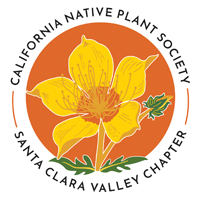


 Western Redbud (Cercis occidentalis) is a deciduous tree that is covered in stunning pink flowers just before leaf emergence in the spring. It is a small tree - growing up to 20' and is fairly tolerant of a wide variety of soils, including clay. While not locally native, it grows well in the Bay Area. There are some beautiful specimens growing near the CNPS SCV Nursery at Hidden Villa in Los Altos Hills.
Western Redbud (Cercis occidentalis) is a deciduous tree that is covered in stunning pink flowers just before leaf emergence in the spring. It is a small tree - growing up to 20' and is fairly tolerant of a wide variety of soils, including clay. While not locally native, it grows well in the Bay Area. There are some beautiful specimens growing near the CNPS SCV Nursery at Hidden Villa in Los Altos Hills.
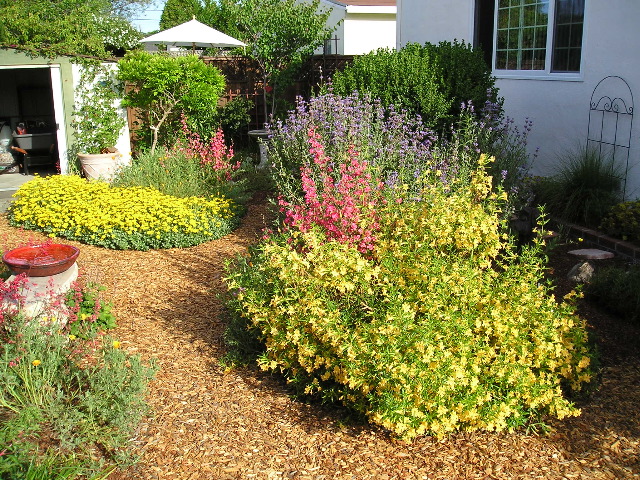 Do you want a garden teeming with life? One that changes with the seasons? One that looks stunning? One that saves water, energy, effort, and money? Consider incorporating California native plants in your garden to attract butterflies, birds, and other wildlife. These beautiful plants will bring seasonal color to your landscape. They will give your California garden a unique sense of place.
Do you want a garden teeming with life? One that changes with the seasons? One that looks stunning? One that saves water, energy, effort, and money? Consider incorporating California native plants in your garden to attract butterflies, birds, and other wildlife. These beautiful plants will bring seasonal color to your landscape. They will give your California garden a unique sense of place.